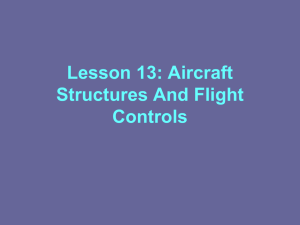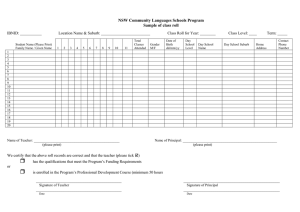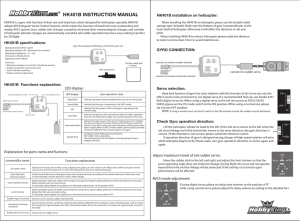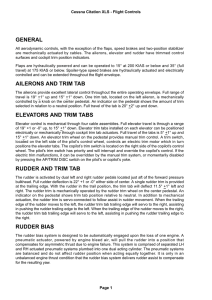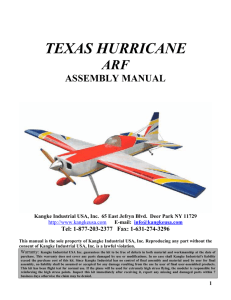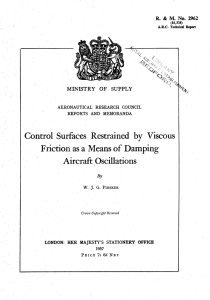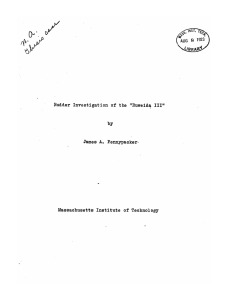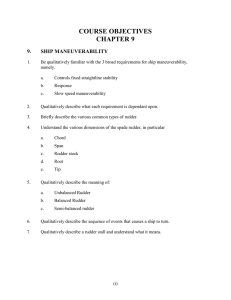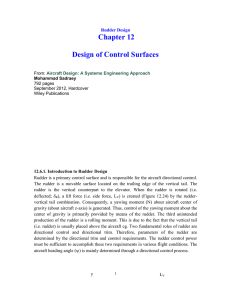D and C PDR 2 - Purdue University
advertisement
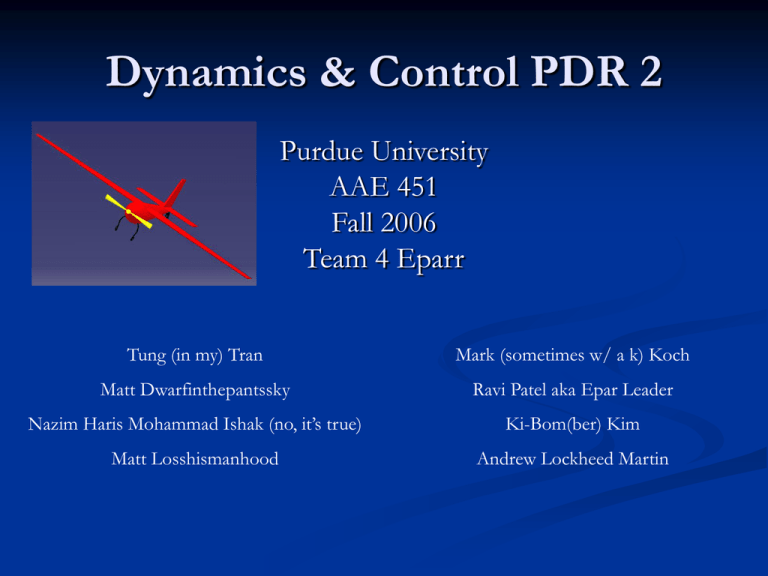
Dynamics & Control PDR 2 Purdue University AAE 451 Fall 2006 Team 4 Eparr Tung (in my) Tran Mark (sometimes w/ a k) Koch Matt Dwarfinthepantssky Ravi Patel aka Epar Leader Nazim Haris Mohammad Ishak (no, it’s true) Ki-Bom(ber) Kim Matt Losshismanhood Andrew Lockheed Martin Overview Control Surface Sizing Trim Diagram Modal Parameters Dutch Roll Feedback Block Diagram Transfer Functions Root Locus of Control System Setting Rate Gyro Gain Control Surface Sizing Historical Data: Cessna Skywagon (Roskam Part II P.261) Elevator: Se=0.45 ft2 Ce= 0.45Cht The elevator will span the entire length of the horizontal tail. Flaperon: Sf=0.4 ft2 Cf=0.245MAC Inboard flaperon location = 0.7683ft from aircraft centerline. Outboard flaperon location = 2.765ft from aircraft centerline. Rudder: Sr=0.172 ft2 Cr= 0.375Cvt The rudder will span the entire length of the vertical tail. Se 0.45 Sh Sa 0.10 S Sr 0.44 Sv Trim Diagram 1 Procedure Calculations (Roskam p. 205) CL CL 0 CL CLe e 0 C m0 dCm C L C me e dC L Cm dCm Static Margin SM x ac x cg dCL CL CM cg CM ac CL ( x cg x ac ) CM ac CL ( SM ) C me Cme Cm CL CLe C m Cm0 Cm CL CL0 CL vs. α Trim Diagram 1 Trim Diagram 2 Procedure Calculations (Roskam, Brandt p.111) CL CL 0 CL CLih ih CLe e 0 C m0 dCm C L C mih ih C me e dC L C mih Cmih Cm tail stall h CL ih 0 d 1 d stall CLih Cmi CL hV h h h Trim Diagram 2 Trim Diagram Conclusion Horizontal Stabilizer Incidence Angle o -1 Max Elevator Deflection Angle -15o Stability And Control Derivatives Stability Control Longitudinal Static Stability Cmα=-1.6265 Usually negative Weathercock Stability Cnβ=0.10193 typically 0.06 to 0.2 Dihedral Effect Clβ=-0.0753 typically -0.09 to -0.3 Pitch, elevator size Cmδe=-2.6408 typically -1 to -2 Yaw and/or roll, rudder size Cnδr=-0.1002 typically -0.06 to -0.12 Roll, flaperon size Clδa=0.285 typically 0.05 to 0.2 Modal Parameters Open Loop Phugoid mode Damping Ratio: 0.495 Natural Frequency: 0.2582 rad/sec Short Period mode Damping Ratio: 0.934 Natural Frequency: 13.248 rad/sec Dutch Roll mode Damping Ratio: 0.2014 Natural Frequency: 8.355 rad/sec Roll mode Time Constant: 0.75 sec Spiral mode Time Constant: 81.89 sec Calculation Reference: Modern Control Engineering Ogata pg.231 Closed loop poles were obtained from Flat Earth. n jd 2 n 2 Dutch Roll Feedback Block Diagram Nominal Gain: -0.11 Dutch Roll closed loop Damping Ratio: 0.841 Natural Frequency: 10.9 rad/sec Futaba S-148 Servo Subsystem Futaba S-148 Servo Linear Model 1 950 surface command s+40 1 s Transfer Fcn Integrator Sum D&C Source Book 1 surface deflection Transfer Functions Aircraft and Servo Transfer Function 69673( s 8.355)( s ^ 2 0.4425s 1.161) ( s 8.369)( s 0.07673)( s ^ 2 3.368s 69.79)( s ^ 2 40s 950) Aircraft Transfer Function 73.3431( s 8.354)( s ^ 2 0.4426s 1.161) ( s 8.366)( s 0.07672)( s ^ 2 3.367 s 69.81) Servo Transfer Function 950 s^2 + 40 s + 950 Rate Gyro Transfer Function 1 Control Law Transfer Function 0.1 Root Locus of Control System Closed Loop Poles for Yaw Rate feedback to Rudder Installation of the Rate Gyro Static Test The gear switch on the radio controller will be used to turn the feedback control system on and off. Up position on the gear switch will be used for no feedback control. The rate gyro should work properly inputting no rudder deflection. Down position on the gear switch will activate the feedback control. Yawing the aircraft should give a rudder deflection in the direction to counter the yaw motion. If the rudder deflection is in the wrong direction switch the rev setting on the gyro. Setting the Rate Gyro Gain Dynamic Test Perform a flight test: The pilot will need to have an additional person help with the control of the gear switch in case the feedback control system causes the aircraft to be uncontrollable. The handling qualities of the aircraft will be determined by the pilot and the feedback gain will be adjusted accordingly. This iterative process continues until the handling qualities are determined satisfactory. Questions?

